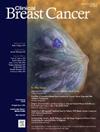机器学习预测早期乳腺癌预后的线粒体特征。
IF 2.5
3区 医学
Q2 ONCOLOGY
引用次数: 0
摘要
简介:乳腺癌是世界范围内主要的女性癌症,线粒体功能障碍可影响乳腺癌的发生。核基因组对线粒体的失调可能导致乳腺癌的发生和发展。然而,对线粒体相关基因作为早期乳腺癌患者总生存的预后标志物的全面研究仍然有限。方法:为了解决这个问题,我们采用机器学习方法来识别一组简明的线粒体相关基因,在预测生存结果方面具有很高的准确性和可靠性。从瑞典癌症基因组分析网络-乳房(SCANB)收集的大量转录组被分为训练和测试数据集,乳腺癌基因组图谱(TCGA-BRCA)被纳入外部验证队列。利用单变量Cox回归、bootstrap和Lasso Cox回归对已知的1136个线粒体相关基因在SCANB训练队列中进行分析,以构建模型。结果:我们在SCANB数据集中发现了一个14个基因的线粒体特征,可以独立预测乳腺癌的生存结局(调整后的风险比[HR]: 2.08, 95%置信区间[CI]: 1.20-3.62)。通过将线粒体特征与临床变量相结合,进一步构建了一个高度预测的nomogram,从而能够可靠地预测1年、3年和5年的总生存期。该模型在训练组(受试者工作特征曲线下面积[AUC]: 0.84, 0.79, 0.78)和验证组(AUC: 0.92, 0.83, 0.78)均表现出较强的预测能力。结论:本研究通过对线粒体相关基因的综合分析,提出了一种新的线粒体特征模型,该模型具有准确预测乳腺癌早期临床预后的潜力。本文章由计算机程序翻译,如有差异,请以英文原文为准。
The Mitochondrial Signature for Predicting Outcome of Early-Stage Breast Cancer by Machine Learning
Introduction
Breast cancer, a leading female cancer worldwide, can be influenced by mitochondrial dysfunction. Dysregulation of mitochondria by the nuclear genome may cause breast cancer initiation and progression. However, the comprehensive investigation of mitochondrial-related genes as prognostic marker for the overall survival of early-stage breast cancer patients is still limited.
Methods
To address this, we employed machine learning methods to identify a concise set of mitochondrial-related genes with high accuracy and reliability in predicting survival outcomes. Bulk transcriptome collected from Sweden Cancerome Analysis Network - Breast (SCANB) was divided into training and testing datasets and the Cancer Genome Atlas Breast Invasive Carcinoma (TCGA-BRCA) was included as the external validation cohort. The 1136 known mitochondrial-related genes were analysed using univariate Cox regression, bootstrap and Lasso Cox regression in the SCANB training cohort for model construction.
Results
We identified a 14-gene mitochondrial signature that independently predicts the survival outcome of breast cancer (adjusted hazard ratio [HR]: 2.08, 95% confidence interval [CI]: 1.20-3.62) in the SCANB dataset. A highly predictive nomogram was further constructed by integrating the mitochondrial signature with clinical variables, enabling robust prediction of overall survival at 1-, 3- and 5-year. This model demonstrated strong predictive capability in both the training cohort (the area under the receiver operating characteristic [ROC] curve [AUC]: 0.84, 0.79, 0.78) and validation cohort (AUC: 0.92, 0.83, 0.78).
Conclusion
In this study, we suggested a novel mitochondrial signature model by comprehensively analysing mitochondrial-related genes, which have the potential to accurately predict the clinical prognosis at the early stages of breast cancer.
求助全文
通过发布文献求助,成功后即可免费获取论文全文。
去求助
来源期刊

Clinical breast cancer
医学-肿瘤学
CiteScore
5.40
自引率
3.20%
发文量
174
审稿时长
48 days
期刊介绍:
Clinical Breast Cancer is a peer-reviewed bimonthly journal that publishes original articles describing various aspects of clinical and translational research of breast cancer. Clinical Breast Cancer is devoted to articles on detection, diagnosis, prevention, and treatment of breast cancer. The main emphasis is on recent scientific developments in all areas related to breast cancer. Specific areas of interest include clinical research reports from various therapeutic modalities, cancer genetics, drug sensitivity and resistance, novel imaging, tumor genomics, biomarkers, and chemoprevention strategies.
 求助内容:
求助内容: 应助结果提醒方式:
应助结果提醒方式:


